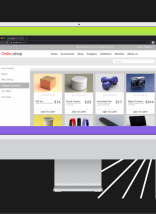What do you expect at a standard brick and mortar store? Imagine it. You approach the building and see the logo clearly displayed. You can see the store hours and contact information on the door. An associate opens the door for you and greets you by name. Then, maybe he or she tells you promotions based on what you bought here before. You browse by going to clearly marked sections of the store. You can pick the products up and see the pieces at every angle. If you need to make a decision, you can pick both up and compare and contrast. If you need any help finding what you need, it’s easy to ask workers how to find it and what product will be best for you. Eventually you go up to the register, maybe take out a rewards program card, buy the product, and leave happy.
There’s no reason someone can’t have that experience in your eCommerce platform. In the words of Bob Willet, former President of Best Buy International and CIO of Best Buy,
“The sooner we drop the ‘e’ out of ‘eCommerce’ and just call it commerce, the better.”
The customer service and customer experience you provide, whether in the digital or ‘in real life’ sphere, should follow the same standards. In fact, it should be better. According to Accenture’s 2014 Holiday Survey, 58% of customers expect a personalized experience when they shop online and 77% of customers expect consistent experiences across all channels. That means whether they’re using a smartphone, a tablet, a laptop, or a desktop, people are expecting the same experience. How can you provide that? Simple—use what tools your platform already gives you. Major eCommerce platforms like Magento come with a variety of custom features to create the kind of experiences people want from a brick and mortar, and much more. Here are 5 simple ways to use eCommerce tools to create that experience.
1. Use Pre-Built Responsive Themes as Reference
To have any chance at a good customer experience at all, an eCommerce site has to be usable on mobile devices. People should be able to easily buy your product whether they’re on a desktop, tablet or a smartphone. It should be as easy to buy products on a phone as it is to send a snarky tweet.
Luckily, major eCommerce platforms usually have a variety of responsive themes and tools for you to use. For example, Magento offers a lot of different options in Magento Connect. Don’t lose what makes your website responsive, but feel free to adjust themes and plugins as you need to make your store uniquely you. The same Accentuate Holiday Survey found Smartphone users interact with their phones 150 times a day—that’s every 6 minutes. If one of those 150 times a customer finds you, they should be able to buy from you immediately. If they have to remind themselves to try your website again on a desktop, you’re going to be forgotten. Don’t let that happen: use the resources Magento and other platforms provide to create an experience customers don’t want to put down.
2. Add 1-Click Ordering to Your Online Store
In September, Amazon’s 20-year patent on 1-click ordering expired. This simple UX feature gave Amazon a significant edge by streamlining the checkout process for its repeat customers.
While we could argue about whether or not this legal advantage should have been granted in the first place, it is more important today that your eCommerce store embrace 1-click functionality. Besides being a major improvement to your site’s user experience, 1-click ordering makes it easier and faster for your loyal customers to purchase from you. Bottom line: this means more sales.
3. Enable Account Creation and Integrate More Payment Methods
Beyond being responsive, one of the best things you can do is allow the creation of custom accounts. This makes it easier on you and your customers. With the information you get from account creation, you can add customers to your mailing list, setup reward programs, and even integrate suggestive selling. On the customer side, checking out becomes even easier with saved information and a customizable checkout flow. In addition, no matter where your customers are and what language they speak, they can buy from you.
In addition, don’t forget to let people pay with their preferred method of payment. Major eCommerce platforms like Magento, Shopify, and WooCommerce have the power not only to accept traditional debit and credit cards but also payment services like PayPal, Google Wallet, and Apple Pay. Just make sure your platform is PA-DSS validated and PCI compliant to legally accept electronic payments. According to the Federal Reserve’s 2015 report on Consumers and Mobile financial services, here is how people paid on mobile last year:
Most Commonly Reported Mobile Payments Services in 2015
| Paypal | 43% |
| Starbucks | 11% |
| Google Wallet | 9% |
| Apple Pay | 5% |
The same report found that 39% percent of all mobile payments made a point-of-sale payment using their phone. By accepting more payments, you’re allowing more customers to pay in the method they want from whatever device they want to shop on.
4. Use Social Media Tools
With few exceptions, our lives are ruled by social media: Facebook, Twitter, Pinterest, Reddit, Instagram, and more platforms every day. These social platforms determine what stories we see and what things we want to buy.
Whether you’re solely an eCommerce business or have a storefront in addition to brick-and-mortar stores, you need to have a social media campaign. It’s just good business. According to the Business Insider, “Facebook accounts for 50% of total social referrals and 64% of total social revenue.” In addition, despite having a user base 6.5x smaller than Twitter, Pinterest drives 16% of traffic to eCommerce sites. There are many tools and add-ons you can use to connect to social media accounts and manage posting. Make sure to integrate those tools to drive more engagement with your site.
5. Have Great Content
It’s easy to forget about content, but beyond images, design, and payment, people need to like what they’re reading. Your style and tone is essential to your brand and engaging your customer base. When you think about the content in your platform, remember the three S’s via Magento U:
- Searchable— Make sure if a customer is searching for a product, they will find yours. That means the title and description of the product should be relevant to what people are searching for.
- Snackable— This term refers to users multitasking and finding small pieces of content and consuming it while they do other things. Whether these content pieces are ads, tweets or facebook posts from your company, you need to have content that can be consumed in small amounts in order to draw in new customers.
- Shareable— The more people who share your content on social media the better. People sharing actually improves your Google search rank (not to mention having more people find you is a good thing). This in mind, be sure to make your content worth sharing.
For extra credit, the content that most people want to see is video content. According to Ooyala’s recent report, more people are watching video content than ever. In fact, using only the data from the video Ooyala hosts, mobile video “made up of 48% of all video views in the quarter, up 14% from a year ago and up 129% from 2014”. Video is a rapidly growing source of content which can only get you more eyes on your site.
Whether you use compelling videos, keyword rich blog posts, or stunning images, great content will bring more eyes and more sales.
If you do these things for your eCommerce platform, you can create a customer experience beyond what they can get at a brick and mortar. These are only some of the things you can do with eCommerce. For more help in creating great experiences for your store, contact us to get started.







